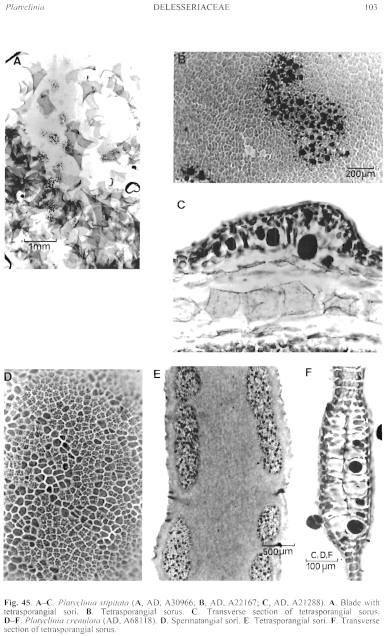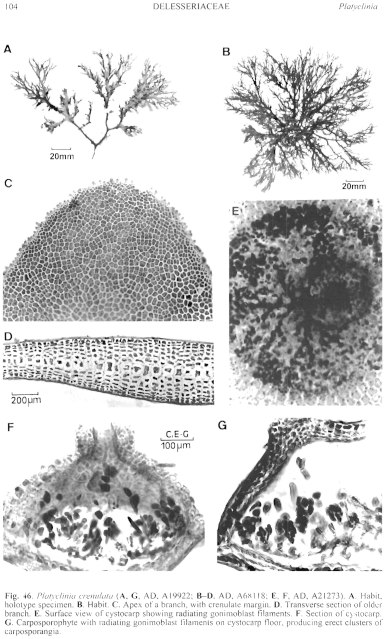|
|
|
|
|
|||||||||||
|
Electronic Flora of South Australia Species Fact Sheet
Phylum Rhodophyta – Family Delesseriaceae
Synonym
Nitophyllum pulchellum sensu Lucas 1926: 596, pl. 37 fig. 1 (NON Harvey) Myriogramme pukhella (Harvey) Millar 1990: 422, in part (see under Nitophyllum pukhellum).
Thallus (Fig. 46A, B) rose-red, fading to grey-red, 4–12 cm high, much branched complanately and marginally, branches (2–) 3–6 mm broad below, (1–) 2–3 mm broad above, more or less linear, margins smooth near apices, becoming convolute below, with a broad midrib present from near apices of main branches, prominent below; veins absent. Holdfast fibrous; epiphytic (on Nitospinosa pristoidea), possibly epilithic. Structure. Growth marginal without distinct apical cells, with frequent but irregular intercalary divisions; many marginal cells around apices and along margins slightly elongate with rounded ends giving a crenulate appearance (Fig. 46C). Mature cells irregular in surface shape, often angular, (15–) 20–30 µm across and L/D 1–2 (–3); marginal crenulate cells 10–20 µm high, only basally conjoined. Blades monostromatic near apices, soon tristromatic and polystromatic in midrib region (Fig. 46D); cortical cells equivalent to the larger primary cells. Cells multinucleate; rhodoplasts discoid.
Reproduction: Gametophytes dioecious. Procarps scattered on blades, structure unknown. Carposporophytes with a central fusion cell and radiating filaments over the cystocarp floor (Fig. 46E, F), cells of filaments fusing, producing erect, branched, clusters (Fig. 46G) of carposporangia which mature together (often in short rows), when mature ovoid to pyriform and 20–30 µm in diameter. Cystocarps usually near the margin of blades, mostly 500–800 µm in diameter; pericarp ostiolate with a distinct collar (Fig. 46F) or slight beak, wall 45–90 µm and 4–6 cells thick. Spermatangial sori (Fig. 45D) small, diffuse and irregular in shape, scattered on wings of blades, 50–300 µm across, with the primary cells producing a layer of initials which bear elongate spermatangia.
Tetrasporangial sori (Fig. 45E) ovate to (usually) linear, 400–600 µm broad, lying between the margins and centre of blades, 160–220 µm thick with 2 layers (Fig. 45F) of tetrasporangia cut off from inner cells of cortical filaments 3–4 cells long, outer cells small and covering subspherical tetrasporangia 45–70 µm in diameter.
Type from Robe, S. Aust., drift (Wollaston, 13.iii.1955); holotype in AD, A19922.
Selected specimens: Robe, S. Aust., drift (Womersley, 2.iv.1999; AD, A68118). Stinky Bay, Nora Creina, S. Aust., drift (Womersley, 19.viii.1957; AD, A21273). Port MacDonnell, S. Aust., drift (G. & R. Kraft 8879b, 19.ii.1992; MELU and AD, A68267). Warrnambool, Vic., drift (G. & L. Kraft 7589, 10.viii.1984; MELU and AD, A68016). Port Phillip Heads, Vic. (Wilson, 10.i.1894; MEL, 676687).
Distribution: Robe, S. Aust., to Port Phillip Heads, Victoria.
Taxonomic notes: P. crenulata is named from the crenulate margins at the apex and below, due to elongate marginal cells with rounded apices; while variable in prevalence, these seem to be a feature of all specimens. MEL, 676687, previously as Nitophyllum pulchellum shows this feature and typical carposporophyte structure.
P. crenulata is closely related to P. ramosa, differing in habit, thallus dimensions, much greater prevalence of crenulate cells, and in having linear tetrasporangial sori (or ovate ones borne in lines) rather than scattered ovate sori as in P. ramosa.
References:
LUCAS, A.H.S. (1926). Notes on Australian marine algae. III. The Australian species of the genus Nitophyllum. Proc. Linn. Soc. N.S.W. 51, 594–607, Plates 37–45.
MILLAR, A.J.K. (1990). Marine Red Algae of the Coffs Harbour Region, northern New South Wales. Aust. Syst. Bot. 3, 293–593.
The Marine Benthic Flora of Southern Australia Part IIID complete list of references.
Publication:
Womersley, H.B.S. (24 February, 2003)
The Marine Benthic Flora of Southern Australia
Rhodophyta. Part IIID. Ceramiales – Delesseriaceae, Sarcomeniaceae, Rhodomelaceae
Reproduced with permission from The Marine Benthic Flora of Southern Australia Part IIID 2003, by H.B.S. Womersley. Australian Biological Resources Study, Canberra. Copyright Commonwealth of Australia.
Illustrations in Womersley Part IIIA, 2003: FIGS 45 D–F, 46.

Figure 45 enlarge
Fig. 45. A–C. Platyclinia stipitata (A, AD, A30966; B, AD, A22167; C, AD, A21288). A. Blade with tetrasporangial sori. B. Tetrasporangial sorus. C. Transverse section of tetrasporangial sorus. D–F. Platyclinia crenulata (AD, A68118). D. Spermatangial sori. E. Tetrasporangial sori . F. Transverse section of tetrasporangial sorus.

Figure 46 enlarge
Fig. 46. Platyclinia crenulata (A, G, AD, A19922; B–D, AD, A68118; E, F, AD, A21273). A. Habit, holotype specimen. B. Habit. C. Apex of a branch, with crenulate margin. D. Transverse section of older branch. E. Surface view of cystocarp showing radiating gonimoblast filaments. F. Section of cystocarp. G. Carposporophyte with radiating gonimoblast filaments on cystocarp floor, producing erect clusters of carposporangia.

|
Email Contact: State Herbarium of South Australia |

|